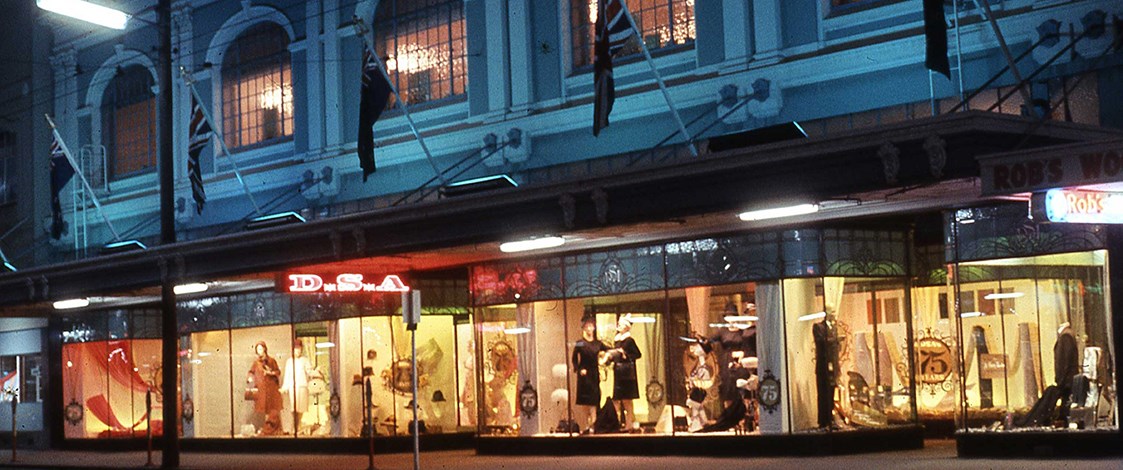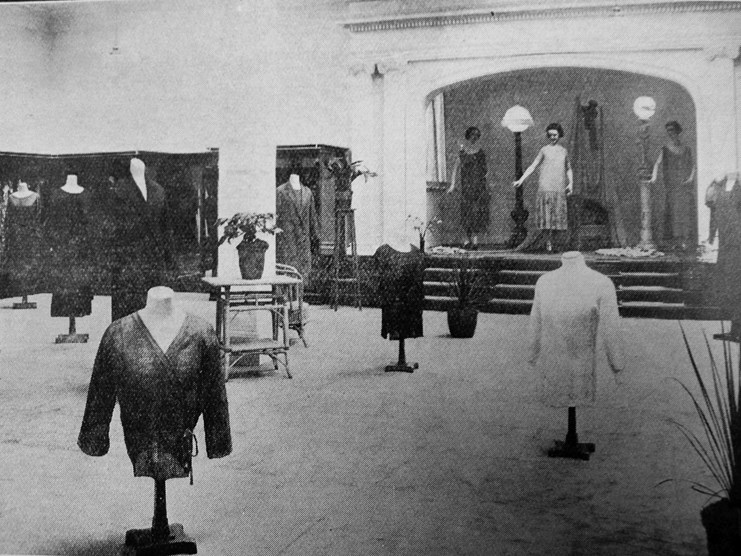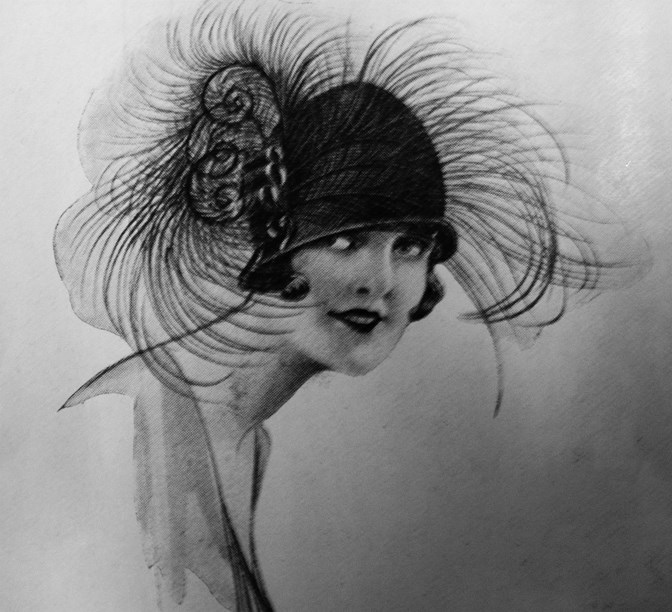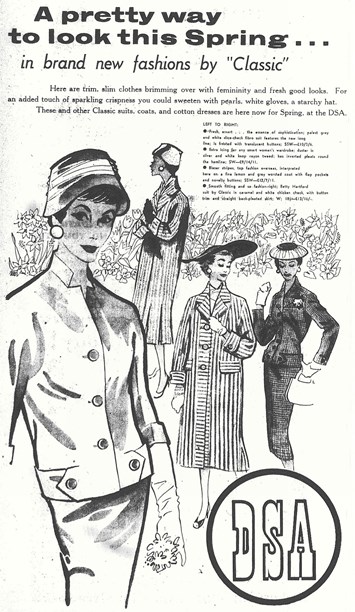Stories
The DSA
1890-1966

From modest beginnings, the DSA (Drapery Supply Association) grew to become one of Dunedin’s major department stores, noted for its high-quality fashion, fabrics, millinery and personalised service. It was originally named Dick & McKecknie, after its young founders James Dick, an apprentice draper from Scotland and David Hunter McKecknie, also of Scottish descent. The business opened in a small, 'furbished up' George Street drapery in March 1890.
The partners were brothers-in-law whose wives were the daughters of Captain Best, presumed drowned at sea when his ship, the SS Kakanui, disappeared on a voyage between Macquarie Island and New Zealand in 1891.
The expectation for the new store was that it would "attract to its doors the custom of the ladies of Dunedin, particularly those resident in the north end of the town".
Reporting on the opening, theOtago Daily Times wrote: "The right hand side of the shop is to be occupied by the dress and manchester departments, and the left hand side by the fancy department, under which designation are included gloves, hosiery, laces and ribbons; while a commodious showroom at the rear is furnished for the display of mantles, millinery and ladies’ underclothing. There is a large extent of accommodation upstairs, where the workrooms for milliners and dressmakers are to be provided."
Focus On Fashion
The fashion of the day was tailored requiring a personalised fit so it was customary for department stores to offer fabric and a dressmaking service. A South Dunedin branch of the store, opened in 1895, also had a sizeable dressmaking workshop. When the DSA moved to larger premises on the opposite side of George Street in 1900, Miss Broome, "a dressmaker who is well-known and appreciated", was listed as one of the main attractions. This was such an important part of the business that even when fashion was less fitted and ready-to-wear clothing became more plentiful, most stores, the DSA included, continued to make-to-measure.
In 1920, the DSA held a Summer Fair and sent a 32-page booklet out to customers, detailing the bargains throughout the store. Chic Hats for Young Ladies were advertised alongside Hats and Toques for Matrons and Imported Model Gowns at Half Price. Mail-order customers were informed that orders for millinery and similar goods requiring boxes were subject to a charge of 9 pence extra for the box.

Velvet hat with tassel. DSA Summer catalogue, 1920.
Architectural Advancements
In the course of expansion, the DSA purchased several adjacent properties and, in 1925, the store was extended to twice its size and completely restructured. The colonnaded Gown Room, or Grand Salon, came in for much praise. Situated at the far end of the salon, framed by a decorative arch, was a miniature stage fitted with a revolving model stand. The stage formed the backdrop for fashion parades and, in later years, became a ladies’ lounge.

Gown Room with stage, The DSA 1925.
Three massive overhead windows set into an outdoor roof garden lit the Grand Salon with natural light, prompting a reporter on a local newspaper to write: "The customer does not now get into dimmer shades on advancing into the interior. The lighting is quite special."
Large double island windows on the street frontage were another notable design feature. Window-shoppers could walk around them and view the displayed items from every angle.
The excitement generated by the DSA’s 1925 rebuild was reflected in the celebratory tone of that year’s Summer Fashion Catalogue. It featured 'A Brilliant Assemblage of Fashion Costumes, Frocks, Coats, Jumpers, etc' and 'Very Dressy Styles in Hats.' Those wishing to trim their own hats were invited to visit the Flower Department where a good selection of 'Silk, Organdie, Velvet and Silver and Gold Tissue flowers' awaited their inspection.

Cloche with feather trim. DSA Summer Fashion catalogue, 1925.
Taste And Refinement
The typical DSA customer was the well-dressed woman for whom good quality, good fit and good taste were paramount. Early advertisements make little mention of fashion labels but Camcraft, Classic, Fashionbilt, Kingsmoor, Ladies Pride, Eastex and Pacemaker, "the dresses that never stay at home", were among the better-known local brands stocked by the store at a later date. Imports included Glamis, Wolsey and Holyrood knitwear, Polly Peck and tailored suits by Matita of London, a member of the Model House Group whose primary function was to promote the export of high-end British fashion.
The Matita label, which featured regularly in British Vogue, was exclusive in Dunedin to the DSA. In 1956, a checked all-wool Matita suit cost 33 pounds while a similar Betty Hartford design by Classic was priced at 13 pounds 16 shillings.
James Dick’s great-grand-daughter Sara McIntyre, a child in the 1950s, remembers Matita. "My mother used to say when talking about the store, 'They sell Matitas, you know.' I knew Matita was special but had no idea why, although that didn’t stop me repeating the phrase."

Classic, manufactured in Auckland, was one of the DSA’s most frequently promoted labels. Betty Hartford suit on right. Otago Daily Times, 1957.
Moving With The Times
The full-skirted, printed cotton dresses produced in their thousands in the 1950s by Betty Barclay, Roystyles, Horrockses, Southwell and Jonathan Logan, provided an informal alternative. They were popular with all age groups, particularly teenagers. Recognising teenagers as a separate demographic group, the DSA opened a Teen & Twenty Shop in the early 1960s.
Photographic records of original artwork from the 1960s indicate the importance of the growing teenage market.
The DSA’s association with swimwear began in the 1920s. When mixed bathing became acceptable and both sexes flocked to the beach to swim and bask in the sun, it was one of the first Dunedin stores to stock bathing costumes for men, women and children. The same singlet-style one-piece, with striped, belted and colour options, was worn by all. Three decades later the store claimed to have "the biggest selection of swimwear in town". Catalina, Rose Marie Reid, Jantzen and Cole of California, which produced sundresses and playsuits as well as swimwear, were four of its key brands. Organised and compered by Joan Wilson, principal of the Joanne School of Charm, swimsuit parades were held in the 1960s in what was formerly the Grand Salon.
The DSA prided itself on its selection of fashionable swimwear.
Child-friendly
Barbara Clarke (nee McKechnie), a grand-daughter of co-founder David Hunter McKechnie, has memories of visiting the store as a child. "There was a lovely hairdressing salon upstairs that had a little red car in which children sat to have their hair cut. I also recall sitting on the Haberdashery counter, when I was little, attempting to sell a pair of gloves!"
In 1925, the DSA claimed to be 'the only retail establishment in the city to maintain a department exclusively devoted to childrenswear.' Over the years, its reputation for top-of-the-line childrenswear grew. In the 1950s, imported brands such as Clydella, Viyella, Madeira babywear and Ladybird pyjamas and dressing gowns were offered in tandem with the best local labels. These included Byron Originals, Childswear (established in the 1940s by former Auckland mayor Sir Dove Myer-Robinson), Poppetwear, for whom Colin Cole and Thornton Hall’s Isabel Harris once designed, and children’s coat specialists Dawnrae. Sara McIntyre recalls owning a coat bought from the DSA when she was six. "It was dark green with a green velvet collar."

The DSA specialised in high quality childrenswear. This advertisement for Dawnrae coats appeared in the Otago Daily Times in 1955.
The Mandatory Hat
Hats were always a big part of the business. Sourced from independent milliners, imported from overseas or made in the store’s own millinery workroom, styles ranged from expensive one-off creations (model hats) to more basic cloches (1920s), trimmed felts (1930s) and berets and Jacoll felts (1957) "priced so sensibly that even your husband won’t object".

Judging from the angle at which these ready-to-wear hats are worn, this advertisement is probably from the 1930s.
In 1953, the DSA was one of the stores chosen to host the Queen Mother’s milliner Aage Thaarup, here to promote his hats in a series of parades throughout the country. His visit preceded by three weeks that of Queen Elizabeth II and Prince Philip, on their first overseas tour since the Coronation. It was hoped the hats would find favour with society figures and the wives of dignitaries attending the Royal events.

Model hats by Condor and Webflex of London. Otago Daily Times, 1956.
By the time Colleen Leith began work as a junior in the millinery showroom in 1963, hats were no longer made on site. She remembers the workroom as a fascinating place from a bygone era. "There were shallow drawers bursting with all sorts of trims, flowers, feathers and so on. Two steam blocks, once used to fashion and stretch hoods, and a commercial machine to stitch brims, were lying idle." She describes the showroom then as being spacious and elegant with large wall-mounted mirrors and smaller free-standing mirrors in which seated customers could view their image while trying on hats. The hats were displayed on wooden stands and model heads on low, felt-covered tables and in glass cabinets. Deep drawers accommodated the rest of the stock.

Colleen Leith, a junior in the DSA millinery showroom (1963 -1966) also modelled in the store’s fashion parades. Receiving her Modelling Diploma from the Joanne School of Charm in 1965, she wears a sheath dress, with detachable train, made from turquoise and silver satin purchased at the DSA. Her beehive hairdo was styled in the DSA hairdressing salon.
End Of An Era
In 1965, the DSA celebrated its 75th anniversary. Special in-store events and fashion parades held to mark the occasion gave no indication that the business, still owned and run by the founding families, was in trouble. When the staff were assembled by the management on 11 July 1966 and told that the store would be closing permanently that day, the news came as a complete surprise.
According to Jim Sullivan, in his book One Hundred Years of Loyalty. The Story of Arthur Barnett Ltd 1903-2003, Invercargill retailer H & J Smith had bought the total DSA assets by a transfer of shares and planned to dispose of all DSA stock within weeks in conjunction with Dunedin department store Arthur Barnett’s.
Interviewed by the media, the DSA’s managing director J Gordon Dick gave the reasons for the closure as "competition, ever-increasing import controls and the high incidence of company taxation".
Barbara Clarke offers a personal perspective: "Gordon Dick, his brother Bob and my father Will McKechnie seemed 'to go with the flow'. They got into a groove and were perhaps too 'nice' and unadventurous to be 'ruthless' businessmen. Competition is not always easy to cope with."
The interior of the DSA building was subsequently dismantled and repurposed as a small shopping mall, Harvest Court. All that remains of the old store are five high arched windows on the upper level of the George Street frontage.
Text by Cecilie Geary. Banner image of The DSA, showing the George Street façade with its double-island windows. Photographed in 1965 during the store’s 75th anniversary celebrations. Image from the R G Dick collection, courtesy of Chloe Dick.
Last published January 2018.